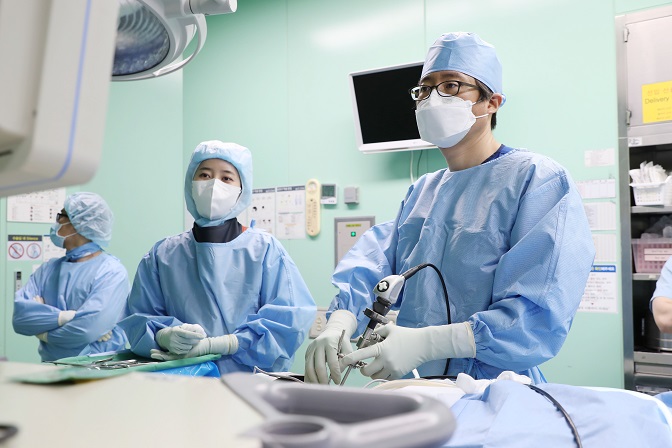[JAN. 2023] Korea-Performed Biportal Endoscopic Spine Surgery Raises Interest Even Among US Doctors
- Name 관리자
- Date 2023-01-31
Korea-Performed Biportal Endoscopic Spine Surgery Raises Interest Even Among US Doctors Q&A with Neurosurgeon Lee Dong-geun, the director of Wiltse Memorial Hospital
What are the benefits of a biportal endoscopic spine surgery that are appealing to many patients and attracting American doctors to come to Korea to learn about it? To find the answers, we met with Dr. Lee Dong-geun, the director of Wiltse Memorial Hospital which has one of the best spine centers in Korea.
1. First, how is endoscopic spine surgery different from conventional surgical methods?
In conventional spine surgeries, an incision is made using a microscope, which inevitably creates some damage to normal tissues before reaching a lesion state. As a result, post-operative pain can be worse with a longer recovery time. Moreover, a patient can suffer from pain that persists even after operation. In contrast, endoscopic spine surgery can be performed with one or two small incisions of 0.5cm~0.7cm that cause nearly no damage to normal tissues before reaching a lesion.
2. Please talk us through the details of the biportal endoscopic surgery and the patient category that this surgical method can apply to.
Biportal endoscopic surgery requires two small incisions of 0.5cm~0.7cm to be made so that a special endoscopy of 8 to 10 magnifications can be inserted in one incision and a surgical instrument can be inserted in the other. Since using both hands broadens a surgeon’s vision and makes it easier to manipulate surgical instruments, this method can be applied to the lesions that cannot be accessed using conventional surgical methods, which allows effective treatment to be provided to various groups of patients. This method can also minimize any damage to the bones, nerves, muscles, or joints, and help maintain the original structure of the spine. Due to smaller scars and significantly reduced bleeding, a shorter admission period is required with a lower possibility of having post-operative complications. In particular, this surgical method can be applied to elderly patients and those with chronic diseases such as high blood pressure and diabetes because it causes less physical stress.
3. What are the advantages of having biportal endoscopic spine surgery in comparison with non-surgical treatments?
While non-surgical treatments can be effective in alleviating pain, they comparatively eliminate the underlying causes. However, even though the treatment process of biportal endoscopic spine surgery may appear similar to non-surgical treatments, it can treat fundamental problems. This includes treatment of thickened tendons or deformed bones that can narrow neural pathways, uneven disc with reduced elasticity, and unstable spine, contributing to a higher level of patient satisfaction.
4. We heard that doctors from many different countries come to Wiltse Memorial Hospital to learn about its biportal endoscopic spine surgery. As a surgeon who performs this procedure, would you like to make any final comments about the surgery before we wrap up this interview?
Our skill in endoscopic spine surgery has grown remarkably to the extent that it may be applied to nearly all kinds of spinal diseases. It might be fair to say that we have the highest skill level in the world, considering that medical staffs from around the world including developed countries are coming to Korea to learn about the surgery. In particular, the overseas medical staffs who have visited our hospital for training wanted to learn about highly technical surgeries such as biportal endoscopic spine surgery or spinal fusion. Many patients with spinal diseases are eager to have safe treatments so that they can comfortably return to their daily lives. It is very likely that ‘biportal endoscopic spine surgery’ can meet their needs to some degree.
HOMEPAGE: https://allspine.com/eng/

